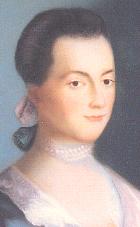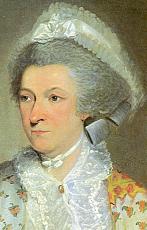
Abigail Adams (November 11, 1744-October 28, 1818) advocated and modeled an expanded role for women in public affairs during the formative days of the United States. Married to John Adams, she was an invaluable partner to him as he developed his political career, culminating in the presidency of the United States. She left a voluminous correspondence, providing information on everyday life and insight into the activities in the corridors of power during her time. Her letters show her to have been a woman of keen intelligence, resourceful, competent, self-sufficient, willful, vivacious, and opinionated—a formidable force. Her writing reveals a dedication to principle, a commitment to rights for women and for African-Americans, fierce partisanship in matters of her husband’s and her family’s interest, and an irreverent sense of humor.
Born in the parsonage of the North Parish Congregational Church of Weymouth to the Rev. William Smith and Elizabeth Quincy, Abigail was raised simply and without pretension, though her relatives, especially on her mother’s side, were among the leading families of their time. To her great regret, she received no formal schooling. She certainly benefited from the many books and the lively conversation in the parsonage. Her lack of education later embarrassed her. She was self-conscious about her inability to spell and punctuate properly or to speak or read French. Even so, Abigail was a devoted reader of history and an astute judge of its impact upon her own time.
Her father, William Smith (1707-1783), was a liberal Congregationalist, who often exchanged pulpits with his friend, Ebenezer Gay. Smith was an Arminian. He did not preach the doctrines of predestination, original sin, or the full divinity of Christ. Rather, he emphasized the importance of reason and morality in religious life. This simple faith his daughter Abigail confessed when she was received into membership in the Weymouth church on June 24, 1759.
That same year, Abigail Smith met John Adams. By 1762 they were exchanging frankly affectionate love letters full of mischievous humor. Their wedding, on October 25, 1764, began one of history’s great partnerships. They were lovers, friends, counselors, and mentors to one another into old age. John did not resent his wife’s abilities to manage a farm and raise a family without him during his long absences on the nation’s business. Rather, he took considerable pride in her accomplishments. He told her she was so successful in budgeting, planting, managing staff, regulating live-stock, buying provisions, nursing and educating her children, that their neighbors would surely remark on how much better things seemed to go in his absence.
From 1783-88, Abigail accompanied her husband on diplomatic missions to France and England. Afterwards, she was glad to return to their farm in Braintree (Quincy). She told Thomas Jefferson she preferred her farm to “the court of St. James, where I seldom meet with characters so inoffensive as my hens and chickens, or minds so well improved as my garden.”
A visit below the Mason-Dixon line strengthened Abigail’s conviction, passionately shared by her husband, that slavery was not only evil, but a threat to the American democratic experiment. Neither John nor Abigail had any use for Southern slavery accommodationists. On March 31, 1776, Abigail wrote that she doubted the distinguished Virginians in the corridors of power had quite the “passion for Liberty” they claimed, since they had been used to “depriving their fellow Creatures” of freedom.
On February 13, 1791, she wrote to her husband regarding a black servant boy who had come to her asking to go to school to learn to write. Abigail enrolled the boy in a local evening school. A neighbor reported serious objections of several people to the black boy’s presence. Swiftly Abigail responded that the boy was “a Freeman as much as any of the young Men and merely because his Face is Black, is he to be denied instruction? How is he to be qualified to procure a livelihood? . . . I have not thought it any disgrace to my self to take him into my parlor and teach him both to read and write.” No further complaints were made.
Often, Abigail spoke up for married women’s property rights and more opportunities for women, particularly in education. She believed that women should not submit to laws clearly not made in their interest. Women should not content themselves with the role of being decorous companions to their husbands. They should educate themselves and be recognized for their intellectual capabilities, for their ability to shoulder responsibilities of managing household, family, and financial affairs, and for their capacity morally to guide and influence the lives of their children and husbands. Although she did not insist on full female enfranchisement, in her celebrated letter of March, 1776, she exhorted her husband to “remember the Ladies, and be more generous and favorable to them than your ancestors. Do not put such unlimited power into the hands of the Husbands. Remember all Men would be tyrants if they could. If particular care and attention is not paid to the Ladies we are determined to foment a Rebellion and will not hold ourselves bound by any Laws in which we have no voice or Representation.”
In 1798, during Adams’s term in the presidency, Abigail was concerned about the influence of the French revolution and troubled by rumors of a forthcoming French invasion of America. She urged her husband to declare war on France. Upset by criticism of her husband and herself in the Republican press for having appointed relatives to important posts, she wrote that “the Liberty of the press is become licentious beyond any former period.” Although the president and the Congress hesitated to go to war, Congress passed the repressive Alien and Sedition Acts. The Sedition Act allowed those who criticized the policies of John Adams to be tried for sedition and possibly treason. Disturbingly, Abigail approved. Adams’s opponents thought that Abigail’s partisanship was too overt and her influence on the president too great. Hence their references to “Her Majesty.”
In her last few months as First Lady, the Adams’ moved into the unfinished White House, a cavernous structure so cold and damp that fires had to be kept lit constantly to make a few rooms habitable. Abigail set up a laundry in one of the great rooms, with clothes lines spanning its vast space. In these challenging and uncomfortable circumstances Abigail showed her usual good cheer and refusal to feel sorry for herself.

Upon leaving public life in 1800, John and Abigail enjoyed a productive retirement at their homestead in Braintree. They took pleasure in their son John Quincy Adams’s rise to prominence, as a U.S. Senator, then minister to Russia, and in 1817 as James Monroe’s Secretary of State. They worried about the errant ways of their sons Thomas and Charles and were concerned about their beloved daughter Nabby’s profligate and spendthrift husband. On the whole, however, they took much pleasure in their family, their prospering farm and their community.
John and Abigail Adams were active members of the First Parish Church in Quincy, which was already unitarian in doctrine by 1753. Although she did not sign the membership book (John did), she attended the church, supported it, and showed active concern and care for its ministry. She is a celebrated figure in her congregation’s tradition. Abigail’s theology is clearly stated in her correspondence. Writing to her son, John Quincy Adams, on May 5, 1816, she said, “I acknowledge myself a unitarian—Believing that the Father alone, is the supreme God, and that Jesus Christ derived his Being, and all his powers and honors from the Father.” “There is not any reasoning which can convince me, contrary to my senses, that three is one, and one three.” On January 3, 1818, writing to her daughter-in-law, Louisa, Abigail wondered “when will Mankind be convinced that true Religion is from the Heart, between Man and his creator, and not the imposition of Man or creeds and tests?” Like many early Unitarians she discounted sectarian claims and was “assured that those who fear God and work righteousness shall be accepted of him, and that I presume of what ever sect or persuasion.”
Death
Early in October, 1818, Abigail fell ill with typhus and died several weeks later. She was buried in the cemetery of First Church in Quincy. John Adams died in 1826 during the presidency of John Quincy Adams.
Sources
Most of Abigail Adams’s correspondence is in the Adams Family Papers and the Warren-Adams Letters, both at the Massachusetts Historical Society. The largest published collection of her letters is contained in L. H. Butterfield, ed., The Adams Papers: Adams Family Correspondence, 4 vols. (1963-73). Other collections include Charles Francis Adams, ed., Letters of Mrs. Adams (1840); L. H. Butterfield, Marc Friedlaender, and Mary-Jo Kline, eds., The Book of Abigail and John: Selected Letters of the Adams Family, 1762-1784 (1975); and Cappon, Lester J., ed., The Adams-Jefferson Letters (1988). Among the many biographies of Abigail Adams and her family are Janet Whitney, Abigail Adams (1947); Charles W. Akers, Abigail Adams, An American Woman (1980); Phyllis Lee Levin, Abigail Adams (1987); and Paul C. Nagel, The Adams Women: Abigail and Louisa Adams, Their Sisters and Daughters (1987).
Article by Laurie Carter Noble
Posted February 28, 2001